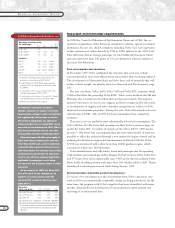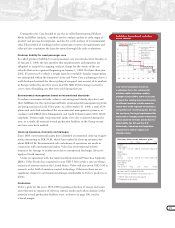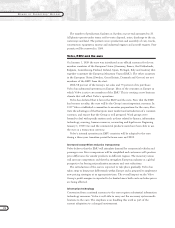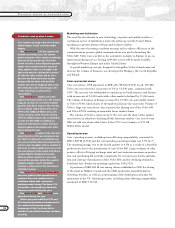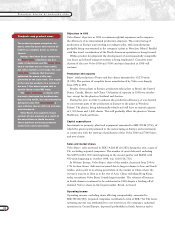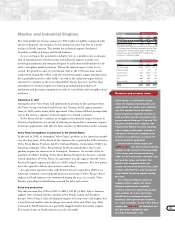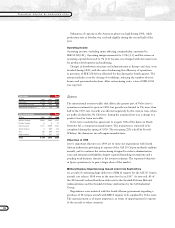Volvo 1998 Annual Report Download - page 30
Download and view the complete annual report
Please find page 30 of the 1998 Volvo annual report below. You can navigate through the pages in the report by either clicking on the pages listed below, or by using the keyword search tool below to find specific information within the annual report.
28
FINANCIAL REVIEW BY BUSINESS AREA
Marketing and distribution
The need for investments in new technology, expertise and quality involves a
continuous review of distribution networks in Europe and the United States,
resulting in a greater portion of large and exclusive dealers.
With the aim of ensuring a uniform message and to achieve efficiency in the
communications process, global communications was used in launching the
Volvo S80. Volvo Cars was first in the automotive industry in Europe to use an
internet purchasing service. During 1999 the service will be made available
throughout Western Europe and in the United States.
A special marketing concept, designed to strengthen Volvo’s brand name and
increase the volume of business, was developed for Hungary, the Czech Republic
and Poland.
Sales and market shares
Cars’ net sales in 1998 amounted to SEK 103,798 M (96,453). In all, 399,680
Volvo cars were invoiced, an increase of 3% or 13,240 units, compared with
1997. The increase was attributable to operations in North America and Europe,
with an increase of 24,300 units while other markets declined by 11,060 units.
The volume of business in Europe increased by 15,580 cars, principally related
to Volvo S/V40, which shares of the market in Europe also increased. Volume of
Volvo’s large cars were lower, due in part to the phasing out of the Volvo 940
and Volvo S/V90 resulting in somewhat lower market shares.
The volume of Volvo’s sales rose by 8,720 cars, and the share of the market
increased on an otherwise declining North American market. One out of every
fifth car sold was a four-wheel-drive Volvo V70 Cross Country or V70 All
Wheel Drive model.
Operating income
Cars’ operating income, excluding items affecting comparability, amounted to
SEK 3,808 M (4,510) and the corresponding operating margin was 3.7% (4.7).
The operating margin rose in the fourth quarter to 4.2% as a result of a favorable
product mix due to the introduction of new Volvo S80. Larger volumes of sales,
positive effects of foreign exchange rates and cost-reduction measures in produc-
tion and purchasing did not fully compensate for cost increases for the introduc-
tion and start-up of production of the Volvo S80, and for declining demand in
Southeast Asia. Return on operating capital was 24% (>25).
A provision of SEK 681 M was among others established in 1998 for closing
of the plant in Halifax, Canada and the CKD-production (assembly kits) in
Göteborg, Sweden, as well as a restructuring of the distribution structure for
spare parts in the US. Operating income, including items affecting comparability,
amounted to SEK 3,127 M.
Cars’ product strategy is based on Sedan,
Estate Wagon, Coupé and Convertible
models.
The Volvo S/V40 is in the segment for
medium-size family cars. The current
product program offers engines producing
between 95 hp and 200 hp. The Volvo
S/V40 1.8i with a direct-injection gasoline
engine was introduced in the spring of
1998, together with a 2.0 T-engine with
light turbo pressure. During the summer
of 1999 the latter variant will be intro-
duced in the North American market.
During 1999 the Volvo S40 and V40
models also will be equipped with a new
direct-injection turbo diesel engine, the
“1.9d,” which has a very low fuel
consumption.
The Volvo S/V70 models are in the
segment for large family cars. The product
program consists of cars with 5-cylinder
gasoline and diesel engines. The V70 has
been available with 4-wheel drive since
1997 in the AWD (All Wheel drive), XC
(Cross Country) and R versions. During
1998 the AWD program was expanded to
include the S70 AWD. In addition, an
improved side-impact cushion that also
protects against head injuries was intro-
duced during the year.
The Volvo S80, a sedan in the size class
above the Volvo S70, was introduced dur-
ing 1998. It represents a completely new
car concept, with product innovations that
confirm and strengthen Volvo’s position in
the areas of safety, quality and concern for
the environment. In the safety field, these
include WHIPS (Whiplash Protection
System), which represents a new seat
concept that provides protection against
whiplash injuries, and IC (Inflatable
Curtain), a refinement of the side-impact
protection system.
The Volvo C70 Coupé and Convertible
are niche products that expand Volvo’s
customer base and combine Volvo’s
traditional values with “exclusivity”
and pleasurable driving. The Volvo C70
Convertible was launched in the North
American market during the year.
The Volvo S/V90 and Volvo 940 were
phased out during the year.
Volvo’s gas-powered Bi-Fuel S70 and
V70 attracted attention in Sweden and in
the continental European market.
Beginning in 1999, the Volvo S80 is
available in two Bi-Fuel versions (methane
and LPG).
Products and product news




